Nearly 100 years have passed since the 1920s, so it’s not surprising that few people can name the presidents of that decade.
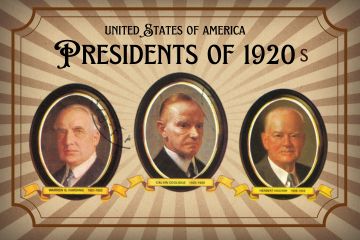
The 1920s were a time of optimism and tremendous financial gains, but everything would change by the end of this decade, and one man would take the blame.
While presidents can’t control everything, a few of the steps the three presidents took (or failed to take) during the previous 10 years had a profound impact on what would come to be known as The Great Depression.
Who Were the Presidents of the 1920s in Order?
There were three presidents during the 1920s, if we don’t count President Woodrow Wilson’s term which ended in 1921 (Don’t worry, we have a separate section for President Wilson below). Here are the three presidents and the inclusive years of their administration:
1. Warren Harding (1921-1923)
2. Calvin Coolidge (1923-1929)
3. Herbert Hoover (1929-1933)
Harding didn’t finish his term due to a fatal heart attack. His Vice President, Calvin Coolidge finished his term and then served another term after winning the presidential election in 1925. He didn’t run for reelection. Hoover, another Republican, took office in 1929, and it was on his watch that the Wall Street Crash of 1929 took place.
- Related Topic: What Happened In The 1920s
Warren Harding
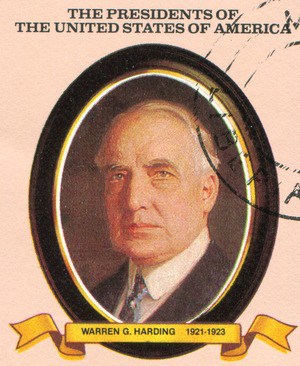
This Republican served as Ohio state senator, lieutenant governor of Ohio, and United States senator before becoming president. He believed that if businesses paid less in taxes, this would give them money to invest in growing their business or employing new people.
Warren G. Harding also increased what is known as protectionism, which was thought to protect American manufacturers from imports.
Perhaps Harding will be remembered most for allowing the Volstead Act to go into effect in 1920, prohibiting the manufacture and sale of alcoholic beverages.
Harding gave jobs to friends who were frequently involved in bribe scandals, such as the Teapot Dome Scandal.
Only 57, Harding died of a heart attack in August of 1923. Although a popular president during his reign, scandals uncovered after Harding’s death saw him reduced to one of the least popular presidents of all time.
Calvin Coolidge

Vice President Coolidge took office after Harding died unexpectedly. Not surprisingly, Coolidge stuck with the same policies initiated by the Harding administration.
Coolidge believed in letting businesses do whatever they wanted to. Coolidge once said that “The business of America is business.”
However, this led his administration to forgo any restrictions on the stock market or the banking industry.
With a booming economy, many people decided to get wealthy from the stock market and even went so far as to borrow money to invest.
This lack of banking regulation is partially to blame for the stock market crash of 1929.
Yet, Coolidge was very popular with the people, even earning a whopping 54 percent of popular opinion.
Herbert Hoover
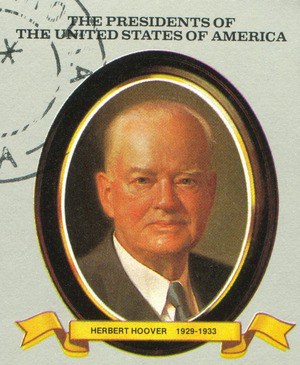
Famous for his presidential election campaign line “A chicken in every pot and a car in every garage”, Hoover would end up taking the blame for the stock market crash and The Great Depression.
Hoover, like the previous two Republican presidents, believed in laissez-faire, which meant that entrepreneurs had the freedom to develop new industries and businesses.
However, this policy also hurt economic growth because the government did not stop big businesses from forming monopolies. Too many small, unregulated banks emerged as a result, and the stock market was not monitored properly.
Protectionism was also something Hoover believed in, and while it may have helped a few small businesses, it hurt larger businesses who were exporting American goods since other countries retaliated by adding taxes to American goods.
Who Was the Most Successful President of the 1920s?

Calvin Coolidge is considered to be the best and most successful president of this decade.
Harding’s administration was corrupt, and Coolidge not only noticed but made sure that once he took office, Harding’s “friends” were removed from their positions.
Coolidge was often called “Silent Cal” because he wasn’t very talkative, but he got the job done.
Coolidge was also one of the few Republican presidents who actually shrank the government. He presided over the majority of the 1920s and did a good job of keeping the economy running smoothly and avoiding conflict.
He was also known for his sense of humor. There is a story told about Coolidge when he was president. President Coolidge and Mrs. Coolidge were being shown [separately] around an experimental government farm. While being shown the chicken yard, Mrs. Coolidge noticed that a rooster was mating very frequently.
She asked the attendant how often that happened and was told, “Dozens of times each day.” Mrs. Coolidge said, “Tell that to the President when he comes by.” Upon being told, the President asked, “Same hen every time?” The reply was, “Oh, no, Mr. President, a different hen every time.” President: “Tell that to Mrs. Coolidge.”
Which President Did a Journalist Accuse of Doing Nothing?
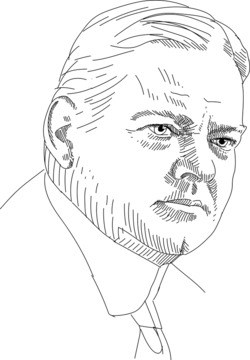
Believe it or not, a journalist by the name of Walter Lippman accused Coolidge of doing nothing, saying “This active inactivity suits the mood and certain of the needs of the country admirably.”
It was actually President Hoover who was the big “do nothing” president, but at this point and time, Silent Cal, as he was called, appeared to do nothing because he failed to talk about plans or accomplishments.
Coolidge was a pessimist and perhaps the most reclusive, but he was also the most accessible president, granting many audiences. He once told a reporter, “Well, Baruch, many times I say only ‘yes’ or ‘no’ to people. Even that is too much. It winds them up for twenty minutes more.”
Coolidge may have been a man of few words, but he was generous with his time.
Coolidge decided not to run for reelection in 1928.
Who Was President in 1919?
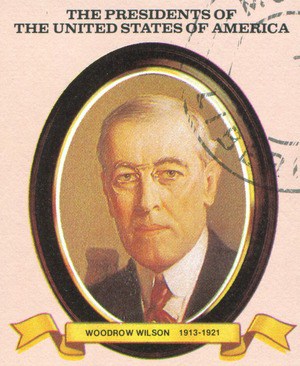
That would be Woodrow Wilson.
Wilson, a progressive Democrat, thought of himself as a protector who was responsible for the people of the United States.
Wilson said, “No one but the President seems to be expected… to look out for the general interests of the country.”
Unfortunately, Wilson brought America into the first world war believing that he was defending democracy throughout the world.
Wilson won the Nobel Peace Prize in 1919 as the leading creator of The League of Nations, a predecessor of NATO. He believed this would stop another world war from happening, but we had World War II in just a matter of two decades.
Wilson also ratified giving women the right to vote, as well as laws against child labor, and established an 8-hour work day for railroad workers.
President Wilson will be remembered as a patriot who was the Father of NATO.
What Did the Presidents of the 1920s Have in Common?
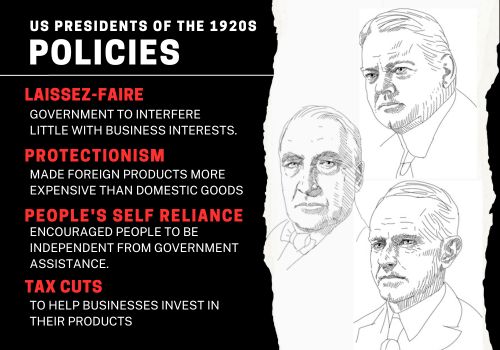
The three presidents of the 1920s all came from the Republican party.
All these presidents believed in certain policies, including:
- Laissez-Faire. This policy meant that government should interfere as little as possible with business interests. On the few occasions that citizens demanded action, these presidents took the side of business interests.
- Protectionism. The Fordney-McCumber Tariff Act of 1922 imposed high tariffs (taxes) on goods from other countries. This made foreign products more expensive than domestic goods which encouraged Americans to buy only American goods. Unfortunately, this also caused other countries to follow suit, making American products more expensive, hurting export businesses.
- People’s Self Reliance and Individualism. They encouraged the people to rely on themselves, independent from government assistance. Hoover dubbed this “rugged individualism”. However, during The Great Depression, there was very little that people could do for themselves. Without cash or food, many died due to malnutrition or outright starvation.
- Tax Cuts. All of these presidents believed in smaller government, but only Coolidge succeeded in that. Tax cuts were believed to help businesses invest in their products. John Q. Public also received tax cuts since government spending was reduced. Businesses saw taxes fall 50 percent, while the average American saw a reduction of only 25 percent.
Coolidge decided not to run for a second term, and Hoover won the American presidential election in 1929.
Which President Died During the 1920s?
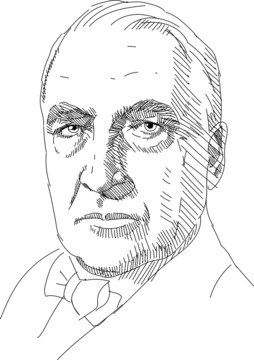
That would be Warren Harding. President Harding died of a heart attack in San Francisco, California, while in the middle of a cross-country tour.
Although the president had appeared to be unwell during certain portions of his visit, his doctor Charles Sawyer, who believed in homeopathy, declared that the president was fit and healthy.
Despite his doctor’s claims, Warren Harding died in bed as his wife was reading to him out loud. While Sawyer tried to claim that Harding died of a stroke, all other doctors believe that Harding had suffered smaller heart attacks that summer and finally died of heart failure on February 3rd, 1924, at 57 years of age.
Final Thoughts 1920s Presidents
As stated earlier, presidents often receive both blame and praise for events that occur in America and even sometimes around the world.
Presidents have limited power, and while they can influence some outcomes, they occasionally end up doing nothing because they simply lack the knowledge of what to do.
Hoover appears to be in the “don’t know what to do so do nothing” camp. His lack of action and what appears to be a lack of empathy saw him removed from power in the 1932 presidential election which saw Democratic party presidential candidate Franklin Roosevelt put into office.
FAQs
1. How many presidents were there in the 1920s?
Three presidents served the American people in the 1920s: Harding, Coolidge, and Hoover. We have excluded President Woodrow Wilson in the list because his administration mostly spanned the 1910s (starting in 1913) and just briefly touched the 1920s (ending in early 1921).
2. Who were the presidents from 1900 to 1920?
The following held the presidency from 1900 to 1920, in order:
1. President William McKinley (assassinated in 1901)
2. Vice President Theodore Roosevelt takes office (1901-1909)
3. William Taft becomes the 27th president (1909-1913)
4. Woodrow Wilson becomes the 28th President (1913-1921)
3. Why is Coolidge considered the most successful president of this era?
Coolidge was not corrupt the way Harding was, and he had no problem dismissing the people that Harding had placed in his administration. He was a man of principles and frugality who “walked the talk”, doing what he said he would, something few presidents can claim.
4. Who were the president and vice president in 1920?
The President of the United States in 1920 was Woodrow Wilson and Vice President was Calvin Coolidge.
Written by Kerry Wisby – GatsbyFlapperGirl.com
Owner & Founder of GatsbyFlapperGirl.com
Kerry Wisby, a former teacher with a BA in English, is the founder of GatsbyFlapperGirl.com. With a passion for all things 1920s, including The Great Gatsby novel, her website is the ultimate source for Roaring Twenties fashion, history, and party ideas. Read more about Kerry here.


















